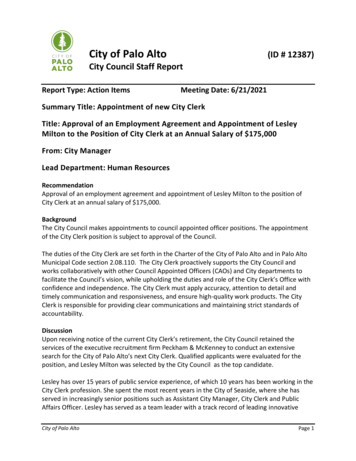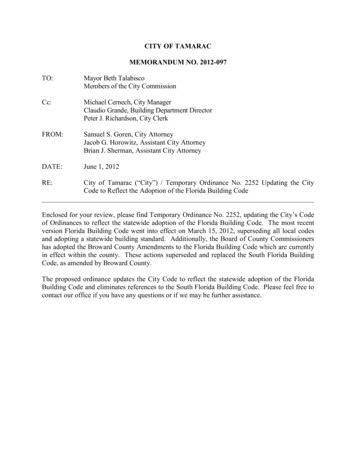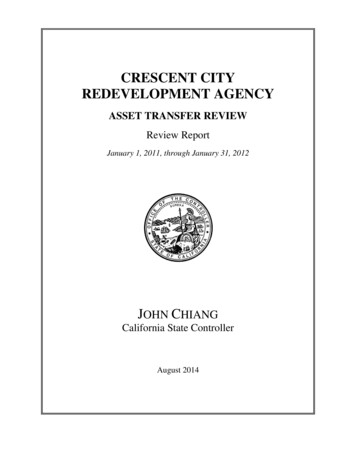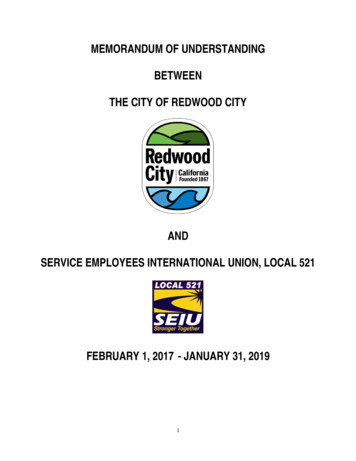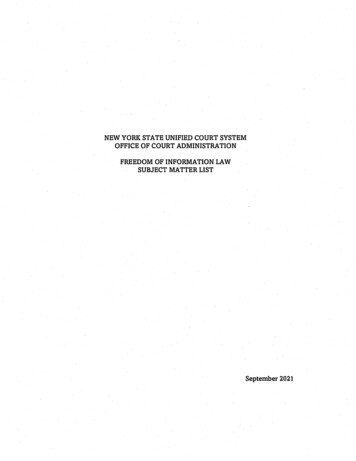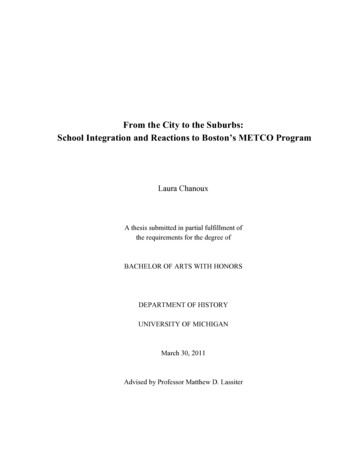
Transcription
From the City to the Suburbs:School Integration and Reactions to Boston’s METCO ProgramLaura ChanouxA thesis submitted in partial fulfillment ofthe requirements for the degree ofBACHELOR OF ARTS WITH HONORSDEPARTMENT OF HISTORYUNIVERSITY OF MICHIGANMarch 30, 2011Advised by Professor Matthew D. Lassiter
For my parents, Anita and Dave Chanoux
TABLE OF CONTENTSFigures. ii-iv, 82Acknowledgements . vIntroduction. 1Chapter One: “A Two-Way Street”. 14Chapter Two: The Value of Integration . 45Chapter Three: “Not At Our Expense” . 83Conclusion . 116Bibliography . 123
FIGURESFigure 1 – Map of METCO districts from the Metropolitan Council for EducationalOpportunity, Inc. website, www.metcoinc.org/AboutUs.html, accessed March 28, 2011.In the 2010-2011 school year, METCO bused Boston students to thirty suburban towns.The first suburbs to join METCO in 1966 were Braintree, Brookline, Newton, Wellesley,Lexington, Arlington, and Lincoln. The rest all joined within the program’s first tenyears.ii
Figure 2 – “Boston and Vicinity,” Rand McNally & Co, 1971, courtesy of the Universityof Michigan Hatcher Graduate Map Library. The highway encircling the city is Route128, which Boston School Committee Chairman John Kerrigan referenced in his 1975“Hub at the Bicentennial” speech.iii
Figure 3 – Map of Boston neighborhoods, 2010, from the Official Website of the City ofBoston, cityofboston.gov. In 1963 the city’s primarily black areas, or “blackboomerang,” consisted of the South End, Roxbury, and Dorchester neighborhoods.Charlestown and South Boston were two with the most vocal populations who opposedbusing for desegregation within the city.iv
ACKNOWLEDGEMENTSI would like to begin by thanking my advisor, Professor Matt Lassiter, for his helpthroughout this past year. Without his confidence during our meetings, I would not havegained the self-confidence necessary to trust my own work. His classes have alsoinspired my work in history in many ways since my first year at the University ofMichigan. Early conversations with Kathy Evaldson and Jonathan Marwil contributed tomy decision to write this thesis, and I thank them both for their guidance. When I hadjust started my research, former Michigan graduate student Lily Geismer helped me tonarrow my focus considerably and gave me excellent advice about sources and research.Thank you to Eric Reed for legal research advice, phone calls to the Suffolk CountyClerk’s Office, editing, and moral support. My thesis cohort further helped ininnumerable ways; specific thanks go to Elaine LaFay, Lauren Rivard, CourtneyMarchuk, Alanna Farber, Caleb Heyman, and Adam Stefanick. Finally, thank you to myfamily and friends who helped me through this process and who will at least tell me thatthey read this thesis.v
INTRODUCTIONEven after the 1954 Brown v. Board of Education decision, which determined thatsegregated education was inherently unequal and in violation of the Fourteenth Amendment,school segregation remained prevalent in both the northern and southern United States. In1967 the U.S. Commission on Civil Rights released a pamphlet titled “Schools Can BeDesegregated,” which made several statements regarding segregated schools in the US: Racial isolation in the public schools is intense and is growing worse.Negro children suffer serious harm when they are educated in raciallysegregated schools, whatever the origin of that segregation. They do notachieve as well as other children; their aspirations are more restricted thanthose of other children; and they do not have as much confidence that they caninfluence their own futures.White children in all-white schools are also harmed and frequently are illprepared to live in a world of people from diverse social, economic, andcultural backgrounds.1The pamphlet demonstrated mainstream liberal views of segregation as a problem for bothblack and white children across the country. While most liberals accepted that separateschools had a negative effect on black students’ self-esteem and success in school, during the1960s they began to realize that it additionally harmed isolated white students. The referenceto “whatever the origin of that segregation” further noted that segregation was not only theproduct of Jim Crow laws in the south, but of varied legal and societal processes in the northas well. The rationale behind busing for school integration movements, therefore, becamefocused not only on correcting inequalities for black students but also for exposing whitestudents to racial diversity.The Metropolitan Council for Educational Opportunity, Inc. (METCO) busingprogram in Boston grew out of these liberal ideologies and worked to give both black urban1U.S. Commission on Civil Rights, “Schools Can be Desegregated” (Washington, D.C.: ClearinghousePublication No. 8, June 1967) 1.1
students and white suburban students integrated educational experiences. Concerned parentsand black activists founded the voluntary program 1966 to provide students from Roxburyand Dorchester with access to superior suburban educational resources while increasingracial diversity in school systems outside the city. In its first year, METCO bused twohundred twenty students who had volunteered for the program to open seats in sevensuburban towns.2 The organization received substantial support from suburban residents andschool committees. Each suburban district guaranteed the urban students a place in theirschools through their high school graduation. By the 1970s, it expanded to bus more than onethousand students and had several thousand students on its waiting list.3 In 2010, METCOhad increased to include thirty suburban school districts and bused roughly three thousandstudents from Boston.While creating integrated school environments was an explicit goal of the METCOProgram, few students or parents in the first years considered it an important part of theirdecision to participate. The small number of METCO students in each town further raisedthe question of whether the program truly intended to correct the societal problem ofsuburban school segregation or whether it was more focused on improving the educationalexperiences of a small number of urban students. METCO gave some students inunderfunded and ill-equipped schools in Roxbury the opportunity to have an education thatideally should be available to all American children, but it did not contribute to correcting theproblems in the city’s schools. Additionally, though the program hoped to increase2“METCO Is Born,” METCO, Inc. website, accessed March 23, 2011, www.metcoinc.org/History.html.Morgan et al. v. Hennigan et al., 379 F. Supp. 410. US Dist. LEXIS 7973; (United States District Court for theDistrict of Massachusetts 1974), [online] LexisNexis Academic Universe.32
integration in the metro Boston area, suburban populations remained largely the same withinthe first decade of the program.Segregation in the NorthThough discussions of segregation in the 1950s and 1960s frequently conjure imagesof Little Rock, Birmingham, and other southern cities, it was pervasive in the northernUnited States as well due to both private restrictions and federal policies. Restrictivecovenants by homeowners barred the sale of residences in white neighborhoods to minorities.Zoning regulations further mandated minimum lot sizes or barred multifamily dwellings, thusmaintaining middle class and racially homogenous suburbs.4 In policy, the Federal HousingAuthority had a significant impact on the creation of suburbia and its racial makeup. Ashistorian Kenneth T. Jackson argues in Crabgrass Frontier: The Suburbanization of theUnited States, “No agency of the United States government has had a more pervasive andpowerful impact on the American people” since the 1930s than the FHA.5 Created during theGreat Depression, it allowed many whites to get home loans to buy houses in the suburbsthrough insuring their long-term mortgages. However, the FHA explicitly denied mortgagesfor homes in neighborhoods that were primarily made up of racial minorities.6 This fact,coupled with the FHA’s policy of more frequently funding single-family homes thanmultifamily homes, meant that few builders or potential owners received FHA support forhousing within crowded cities.7 As Jackson explains, these policies “hastened the decay of4Thomas J. Sugrue, Sweet Land of Liberty: The Forgotten Struggle for Civil Rights in the North (New York:Random House, 2009), 202.5Kenneth T. Jackson, Crabgrass Frontier: The Suburbanization of the United States (New York: OxfordUniversity Press, 1985), 203.6Sugrue, 203-204.7Jackson, 207.3
inner-city neighborhoods by stripping them of much of their middle-class constituency.”8Cities developed into areas of primarily minorities and working-class whites.However, few suburbanites recognized these obstacles to homeownership that kepttheir towns racially segregated. To them, segregated neighborhoods were rather the result of“individual decisions” and the freedom to choose where one wanted to live.9 Thisunderstanding of segregation ignored the economic and institutional barriers that kept blackpeople from having the ability to move wherever they wanted and contributed to the idea thatsuburbanites had simply earned enough money to achieve the “American Dream” of privatehomeownership. Additionally, moving to the suburbs frequently gave white parents anescape from desegregation in their children’s urban schools.10 They did not see themselvesas perpetuating segregation, since they were making individual choices about where theywanted to live – choices that black families could supposedly make as well.Residential segregation, both within cities and between cities and suburbs,contributed to school segregation in many major metropolitan areas. After Brown v. Boardof Education, many northern schools that had not been explicitly segregated through de juresegregation remained racially homogenous. However, many northerners believed that schoolsegregation was simply a southern problem. Black activists recognized educationalinequalities and filed court cases in the north to try to integrate northern schools. The 1961New York case Taylor et al. v. Board of Education of New Rochelle for the first timechallenged de facto school segregation in the north, or segregation that had not been legallymandated. However, instead of explicitly arguing that de facto segregation wasunconstitutional, it succeeded based on the same grounds as Brown v. Board – that8Jackson, 206.Sugrue, 466.10Sugrue, 467.94
segregation was unconstitutional when it was the direct result of intentionally discriminatorypolicies.11 Students who had attended New Rochelle’s segregated school were bused toother, integrated schools and eventually school board closed the school in question. In Gary,Indiana in 1962, an NAACP case against the Gary school officials alleging intent tosegregate the schools failed, and the judge ruled that the school board could not be heldaccountable for residential segregation.12 Few lawyers attempted to prove that deliberatepolicies had created residential segregation and thus racially homogenous neighborhoodschools were unconstitutional.Even in successful court cases, however, the question of how schools should beintegrated remained controversial, as many northern whites did not want their childrenaffected by desegregation efforts. As Thomas J. Sugrue found in his analysis of civil rightsactivism in the north, though many northern whites “approved of desegregation in principle,[they] opposed it in practice.”13 Often integration efforts prompted backlash and accusationsof reverse discrimination. Many whites felt that black and Hispanic people were gainingrights at their expense.Busing was one of the most common approaches to integration, and Charlotte, NorthCarolina, proved that metropolitan school systems could be effective methods of todesegregate schools both racially and economically. The 1969 case Swann v. CharlotteMecklenburg, reviewed by the Supreme Court in 1971, sought to integrate the city’s publicschools and launched controversy over busing that continued into the 1970s.14 However, themetropolitan plan ultimately succeeded, and “a large majority of white families in Charlotte11Sugrue, 197.Sugrue, 462.13Sugrue, 465.14Matthew D. Lassiter, The Silent Majority: Suburban Politics in the Sunbelt South (Princeton: PrincetonUniversity Press, 2006), 133.125
Mecklenburg decided that they could reconcile their own versions of the American Dreamwith enrollment in a comprehensively integrated school system.”15 School integration didnot solve residential segregation, but it did show that cities and suburbs could work togetherto create integrated educational environments.16Contrary to the success in Charlotte, the 1972 case in Michigan, Bradley v. Millikenclosed the door for metropolitan-style solutions to school integration. The judge in Millikenruled that a metropolitan school district would be created to integrate both Detroit and thesurrounding suburbs. Suburban whites usually avoided desegregation by virtue of theirgeographic location, but the Bradley v. Milliken ruling denied them such an opportunity.Visceral reactions to the court order avoided racial language but instead focused on theimportance of “neighborhood schools” and the idea that parents had moved to townsspecifically for the school district.17 The Supreme Court overturned the metropolitan plan ina 5-4 decision, refuting the argument “that school districts were creatures of the state and thattheir boundaries could be redrawn in service of larger educational goals.”18 Because theSupreme Court had allowed suburbs to escape from integration efforts, urban working-classwhites and minorities were forced to deal with school segregation on their own and voluntaryprograms such as METCO became the only way to promote suburban desegregation.Segregation in BostonA variety of factors led to segregation in the Boston Public Schools; one of theprimary causes was the residential makeup of both the city and suburbs. Federal policies15Lassiter, 217.Lassiter, 221.17Sugrue, 483.18Sugrue, 487.166
created neighborhoods deeply divided by both race and ethnic background in the city as wellas in racially isolated suburbs. In 1960, black people made up 2.2 percent of the populationof Massachusetts, and roughly 50 percent of black state residents lived in the city ofBoston.19 Between 1950 and 1960, the white population in Boston decreased by 17 percentwhile white suburban populations increased by 16 percent, illustrating the “white flight” tothe suburbs.20 The suburbs of Boston were extremely segregated in the 1960s, though fewsuburbanites viewed them as such. In Middlesex County, where many of the first METCOtowns were located, roughly one percent of the households were nonwhite, and likely asmaller percentage of that one percent was African American.21 The previously discussedFHA restrictions and other discriminatory practices maintained the racial homogeneity ofmetro Boston.The majority of black people in Boston lived in an area termed the “blackboomerang,” made up of neighborhoods in Roxbury, Dorchester and the South End. A 1963report by the Advisory Committee to the US Commission on Civil Rights exposed thenumerous obstacles that kept black people from buying or renting property in certain sectionsof the city. Using tactics ranging from clear rejection to “ostensibly nondiscriminatoryrejection real estate brokers, developers, landlords, and homeowners” continuously refusedto allow black people into certain areas.22 School districting followed neighborhood lines,though in the early 1970s black parents filed a civil lawsuit that proved that the BostonSchool Committee specifically organized school districts on racial lines.19The Massachusetts Advisory Committee to the United States Commission on Civil Rights “Report onMassachusetts: Housing in Boston,” December 1963, 2.20“Report on Massachusetts: Housing in Boston,” 2.21Of 361,543 households recorded in the 1960 census for Middlesex County, 4,744 were nonwhite. Theserecords did not indicate which races made up the nonwhite statistics, but presumably many minorities insuburban Boston were Asian. 1960 Census Data from Social Explorer Professional, www.socialexplorer.com,accessed March 23, 2011.22“Report on Massachusetts: Housing in Boston,” 20.7
The suburbs of Boston did not just keep minorities out; white families who were notin the middle and upper classes could not afford to move to the suburbs either. This becamea major issue as busing within the city began in the 1970s. Urban whites were frustrated bythe “suburban elites” who could judge their refusal to integrate the Boston Public Schools,yet “snob zoning” kept suburban towns and school systems from integrating. Sometimesreferred to by urban whites as the “friggin’ liberals in the suburbs,” suburbanites felt thetension between urban and suburban Boston, despite some towns’ efforts to correctsegregation through the METCO Program.23With school districts determined by neighborhood and thus segregated both withinthe city and in the suburbs, black students in Boston found themselves in a difficulteducational environment. Many studies showed that segregated education had a detrimentaleffect on young nonwhite children, and Jonathan Kozol, a teacher in the Boston public schoolsystem in 1965, reinforced this through his book Death at an Early Age, which described hisexperiences working at an all-black school in Roxbury. The school was rundown and whilethe majority of the students were black, most of the teachers were white. Students did nothave access to the resources they needed due to poor funding, inadequate supplies, and a lackof teachers willing to work with struggling children. After several months he becamedesensitized to the problems around him, slowly absorbing the attitudes of his coworkers. Acommon sentiment among other teachers was that a “Negro was acceptable, even lovable, ifhe came only when invited and at other times stayed back.”24 This idea could be seen in thesuburbs of Boston as well, even in towns that had an overall positive reaction to the METCO23John J. Kerrigan, quoted in Robert Reinhold, “More Segregated Than Ever,” New York Times, September 30,1973.24Jonathan Kozol, Death at an Early Age: The Destruction of the Hearts and Minds of Negro Children in theBoston Public Schools (Boston: Houghton Mifflin, 1967), 22.8
Program. Kozol concluded that being educated in such an environment put children at ahuge disadvantage from an early age, ultimately causing them to lose their spirits and dreamsfor a positive future. Concerned parents and activists also saw this and worked to find waysto get their children out of these situations. For some students, METCO became an escaperoute from Boston and a tool to achieve a better education and a better socioeconomic future.The arguments for and against the METCO Program demonstrated the limits tosuburban liberalism in the historically progressive state as well as class conflicts betweenurban and suburban whites. The METCO Program caused major debates in its first decadeabout race-conscious programs, the value of integration, and whether racial integration wasas important as economic integration. Busing forced people living in suburbs to confront thepotential discrepancies between their political ideologies and the realities of what theywanted for their towns and especially their school systems. Debates about METCO withinthe city questioned the purpose of the program and its emphasis on racial integration in thesuburbs. Many urban working-class whites viewed it as a racially discriminatory programthat only focused on helping black children and left white students abandoned inunderfunded city schools. METCO resisted efforts by urban legislators and Boston SchoolCommittee members to expand the program significantly, raising the question of whetherMETCO had been created to solve a problem in the city or just help the relatively smallnumber of black students who participated in the program each year.Though criticism of METCO played a role in arguments about court-ordered busing,most historians focus on the crisis within the city instead of on busing to the suburbs. RonaldP. Formisano, in Boston Against Busing: Race, Class, and Ethnicity in the 1960s and 1970s,mentioned METCO briefly in his history of the anti-busing movement within the city. He9
concluded that it was a “classic privatist solution to a general social problem – inferioreducation of black children – that addressed it by setting up a funnel through which only afew could pass to a better education and increased life opportunities.”25 He critiqued theprogram for pulling the brightest students out of the Boston public schools, distracting fromcity schools’ issues, and attempting to solve a societal problem on an individual level.Formisano concluded that the children in METCO came from middle class families, and thusthe program left behind poor urban black students and “exaggerated the separation ofclasses.”26 While Formisano blamed METCO for the continued deterioration of the Bostonpublic schools, he did not analyze the program’s focus on integrated education. Rather, tohim METCO seemed to be entirely about giving middle class black children from the cityaccess to well-funded educational resources in the suburbs. Any benefits of integration weresimply a gloss by which the program sold itself to suburban communities.By contrast, Susan Eaton’s The Other Boston Busing Story provides an in-depthanalysis of METCO through interviews with sixty-five graduates of the program. UnlikeFormisano, her evaluation of METCO’s goals is that the program means to “correctdisparities” between Boston and the suburbs.27 Her work focused on the experience ofMETCO students and the ways in which they considered the program a success or a failure.Many commented on the challenges of being a METCO student, which included feelingdisconnected from the culture of their hometowns, feeling pressure from their friends inBoston who were not working as hard academically, and dealing with the prejudices anddiscrimination that came with frequently being the only black student in a classroom.25Ronald P. Formisano, Boston Against Busing: Race, Class, and Ethnicity in the 1960s and 1970s (ChapelHill: University of North Carolina Press, 1991), 231.26Formisano, 231.27Susan Eaton, The Other Boston Busing Story: What’s Won and Lost Across the Boundary Line (New Haven:Yale University Press, 2001), 219.10
Several of the students Eaton spoke with referred to their school years as a sort of hell. Manyexplained that their parents had pushed them into the program, and nearly all had someconcept of being in METCO in order to get a better education. When asked if they wouldrepeat the experience or send their own children, most of the people Eaton interviewed saidthey would.28 Despite the challenges, they recognized the advantages that an integratedsuburban education had given them. Eaton’s work provides insight into students’perspectives and how their lives were affected by METCO, yet does not discuss suburbanreactions aside from racial name-calling and other instances of misunderstanding ordiscrimination within the schools.Despite criticism and budget cuts, METCO still functions in Massachusetts and iscurrently in its forty-fifth year. As Formisano has explained, METCO has a “sacred cow”status in the state as a well-loved institution and each year lobbies the state legislature foradditional funds to continue the program.29 The proposed METCO budget for the 2011-2012school year was 17.6 million, reflecting a fifteen percent cut since 2008 as well as thesubstantial size of the financial commitment Massachusetts made to the program.30 DespiteMETCO’s long-lasting presence in the state, its duration contradicts its original intention tobe a short-term solution to educational problems in the city and to aid with schooldesegregation in the suburbs. While the busing program has been an invaluable resource thathas undoubtedly improved the educational experiences of many students and helped sendmany urban students to college, it only helps three thousand of the tens of thousands ofBoston students. It has not improved the Boston school system, but rather it has given28Eaton, 198.Formisano, 231.30“METCO Legislative Alert,” METCO, Inc. website, updated February 28, tml.2911
individual students an opportunity to remove themselves from Boston the city in pursuit ofbetter educational resources. Additionally, while many former students in Susan Eaton’sstudy identified the benefits of attending a majority-white school, integration had not beentheir ultimate goal when volunteering for the program. Though integration is still animportant part of METCO’s mission statement, the disconnect between students’ goals andthe program’s goals again raises the question of whether METCO is truly correcting societalproblems or simply giving some students access to suburban resources.An understanding of the reactions to METCO exposes the complex relations betweenrace, class, and geographic location in the Greater Boston area as well as changes in societalopinions towards school integration and affirmative action programs across the country. Thisthesis will examine METCO’s origins and roughly the first decade of the program from 1966to the mid-seventies through several viewpoints: METCO administrations, white suburbanliberals, suburban opponents of METCO, urban activists, and white working-class criticismsof METCO through urban resentment towards the suburbs. METCO was fiercely debated inthe suburbs and within Boston, and those debates reveal conflicting understandings of theprogram and its purpose in the state. Though many suburbanites and parents of black urbanstudents believed that the program was a positive step towards achieving a more equitablesociety, others focused on the program’s cost and potential negative effects on schools,suburban children, and towns themselves. Not all of the suburbs around the city participatedin the program, and many who discussed METCO ultimately voted against joining. Manysuburbanites held similar views to those of working class white Bostonians, demonstratingthe ideological diversity in the suburbs. Boston residents’ criticisms of the program revealed12
deep resentments towards the suburbs, viewing suburbanites as liberals who only embracedtoken desegregation while criticizing segregation in the city.By the 1970s, many people in Boston and surrounding towns began to see METCOnot as an effort to correct historic discrimination, but rather a discriminatory program whosefocus on race conflicted with the idea that the solution to prejudice was to create a “colorblind” society. The conflict between the desirability of “race-conscious” and “color-blind”programs reflected national shifts in understanding of the purpose of the Civil RightsMovement and the need to integrate schools in the United States. Programs such as METCOthat sought to correct years of discrimination towards African Americans received attentionfor giving one race an unfair advantage over others. Backlash toward METCO and towardaffirmative action nationally ignored the history and long-lasting effects of discrimination inthe United States and recast the white majority as victims of minority demands.13
CHAPTER ONE: “A Two-Way Street”The Metropolitan Council for Educational Opportunity, Inc., Program developed inthe latter half of 1965 after several years of civil rights action, parental dissatisfaction withthe Boston public schools, and the passage of the Racial Imbalance Law. Though creatorsproposed the program as a short-term solution to urban school problems, soon the organizersbegan discussing a more permanent future. Though the first school committees who voted toaccept the program welcomed the opportunity to assist students from the city, METCO staffworked to educate suburban staff on the different situation in which METCO students foundthemselves. Additionally, METCO officials emphasized that suburban integration wasbeneficial to both urban and suburban students – a “two-way street” that would positivelyaffect racially isolated or segregated students in the Greater Boston area. This chapter willexamine the program’s origins, its structure, the METCO suburbs, interactions between thesuburbs and the city in the first few years, and METCO student experiences.Parent Organization for School Improvement and DesegregationBy the 1960s, the Boston public school system had deteriorated to the point thatparents started to take actions to improve the quality of education provided for their children.African American parents in particular realized that despite the 1954 Brown v. Board ofEducation case overturning the ideology of “separate but equal,” their children attendedsegregated and inferior schools. Though many white urban parents insisted that their ownchildren attended dilapidated schools, the justices in Brown v. Board and other re
hundred twenty students who had volunteered for the program to open seats in seven suburban towns.2 The organization received substantial support from suburban residents and school committees. Each suburban district guaranteed the urban students a place in their schools through their high school graduation.




